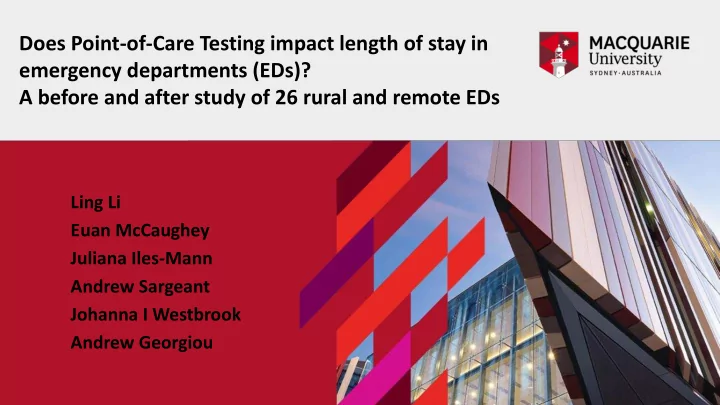

Does Point-of-Care Testing impact length of stay in emergency departments (EDs)? A before and after study of 26 rural and remote EDs Ling Li Euan McCaughey Juliana Iles-Mann Andrew Sargeant Johanna I Westbrook Andrew Georgiou
Centre for Health Systems and Safety Research 2
Point-of-Care Testing (PoCT) • Refers to “tests performed near patients and outside a traditional laboratory” (Nichols 2013) • One of the fastest growing sectors in in-vitro diagnostics (Huckle 2013) • Fast growth facilitated by • advances in technology • greater integration with electronic systems • implementation of policies and standards enhancing test accuracy and safety (RCPA QAP 2012) Twitter: #HIC18 @lli_sydney 3
PoCT: Key advantages • Enhanced access, esp. in rural and remote areas (Shephart 2013) • Faster test turnaround time, decision making and treatment (Lee-Lewandrowski 2010; Rooney 2014) • Increased patient/clinician satisfaction (Blattner 2010) Twitter: #HIC18 @lli_sydney 4
5
The world’s largest accredited managed PoCT service • 550 PoCT devices • 360 EDs • 185 hospitals http://www.pathology.health.nsw.gov.au/clinical-services/point-of-care-testing (NSW Health Pathology, 2018) Twitter: #HIC18 @lli_sydney 6
Aim: To examine the impact of PoCT on the length of stay (LOS) in rural and remote EDs Twitter: #HIC18 @lli_sydney 7
Study design and setting • A retrospective before and after study • 26 rural and remote EDs in Murrumbidgee Local Health District (LHD) • Study period: Jan 2013 – Apr 2015 • PoCT implementations: Mar – Apr 2014 Twitter: #HIC18 @lli_sydney 8
Available PoCT tests iStat Cartridge PoCT Tests cTnI Troponin I CG4+ Bicarbonate, PCO 2 , Lactate, pH, sO 2 , PO 2 , HCO 3 , Base Excess Chem8+ Potassium, Sodium, Chloride, Bicarbonate, Anion Gap, Ionised Calcium, Glucose, Urea Nitrogen, Creatinine Twitter: #HIC18 @lli_sydney 9
Data reconciliation and quality assessment • Only 29% of PoCT data were reconciled from AQURE to LIS • PoCT results would have been used for the decision making Twitter: #HIC18 @lli_sydney 10
Study population Patients presenting with a circulatory system illness – unplanned, 1 st presentation only (N=7961) Patients discharged home from EDs (N=3808) Pre-PoCT Post- PoCT (N=2092) (N=1716) Twitter: #HIC18 @lli_sydney 11
The 4-hour rule Proportion of patients discharged home from EDs within 4-hours of presentation Pre 82.2% (95% CI: 80.5% - 83.8%) Post 86.8% (95% CI: 85.2% - 88.4%) P <0.0001 12
Observed ED LOS Twitter: #HIC18 @lli_sydney 13
Statistical modelling Generalised Estimating Equation (GEE) model • Correlation of patients presented to the same EDs • With a log-link function to fit skewed ED LOS • Adjusting for patient demographics and clinical characteristics Twitter: #HIC18 @lli_sydney 14
Estimated ED LOS (minutes) Pre VS Post, p=0.07 Pre 134 (95% CI: 116 – 155) Post 123 (95% CI: 109 – 139) 15
Other significant factors Age category, p=0.02 <31 31-50 51-70 >=71 0 50 100 150 Estimated ED LOS (minutes) 16
Other significant factors Triage category, p=0.04 Immediately life threatening (T1) Imminently life threatening (T2) Potentially life threatening (T3) Potentially serious (T4) Less Urgent (T5) 0 50 100 150 200 Estimated ED LOS (minutes) 17
Other significant factors ED arrival time, p=0.02 1 AM-7 AM 7 AM-1 PM 1 PM-7 PM 7 PM-1 AM 0 50 100 150 200 Estimated ED LOS (minutes) 18
Other significant factors Day of week, p=0.02 Mon Tue Wed Thu Fri Sat Sun 0 20 40 60 80 100 120 140 160 Estimated ED LOS (minutes) 19
Discussion • Not conclusive after considering other important clinical factors • Consistent with existing limited international evidence (Rooney 2014; Pecoraro 2014) • ED LOS varied with time of day and day of week (Li 2015) – Better targeting ED resources and staffing to reduce ED LOS • Less than 1/3 of PoCT data was reconciled to the LIS – Lack of real- time patient information in rural and remote EDs • Sophisticated modelling approach could be applied in the future as the quality of PoCT data improves. Twitter: #HIC18 @lli_sydney 20
Ethics approval Greater Western Area Health Service Human Research Ethics Committee (Project No. LNR/15/GWAHS/26) Site Specific Assessment approval Far West LHD (SSA No. LNRSSA/15/GWAHS/48), Murrumbidgee LHD (SSA No. LNRSSA/15/MLHD/8) Western NSW LHD (SSA No. LNRSSA/15/GWAHS/49) This project was funded by NSW Health Pathology. Twitter: #HIC18 @lli_sydney 21
Research Team Steering Committee Sue Carter (Director, Planning and Maria Dahm (Post-Doctoral Research Fellow) Performance NSW Health) Andrew Georgiou (Professor) Dominic Dwyer (Network Director, Pathology West) Ling Li (Senior Research Fellow) Julianna Iles-Mann (Pathology ICT Manager, Euan McCaughey (Post-Doctoral Research Pathology West) Fellow) Virginia Mumford (Post-Doctoral Research Andrew Sargeant ( Director Point of Care Fellow) Testing Services) Keira Robinson (Research Assistant) Michael Whiley (Director of Clinical Strategy and Reform) Johanna Westbrook (Director, Professor) Roger Wilson (Chief Pathologist) Health Informatics Conference 2018 22
Selected references • J.H. Nichols, Point-of-care testing, in: The Immunoassay Handbook: Theory and applications of ligand binding, ELISA and related techniques, D. Wild, ed., Elsevier Oxford, UK, 2013, pp. 455-463. • Royal College of Pathologists of Australasia, Point of care testing, Common Sense Pathology April 2015 (2015), 1-8. • M. Shephard, Point-of-Care testing in Australia: The status, practical advantages, and benefits of community resiliency, Point of Care 12 (2013), 41-45. • E. Lee-Lewandrowski and K. Lewandrowski, Point-of-care testing in the Emergency Department, in: Point-of-Care Testing: Needs, Opportunity and Innovation, C. Price, A. St John, and L.L. Kricka, eds., AACC Press, Washington, DC, 2010, pp. 397-410. • K.D. Rooney and U.M. Schilling, Point-of-care testing in the overcrowded emergency department - Can it make a difference?, Critical Care 18 (2014). • L. Li, A. Georgiou, E. Vecellio, A. Eigenstetter, G. Toouli, R. Wilson, and W. JI, The impact of pathology testing on Emergency Department length of stay: A multi-hospital longitudinal study applying a cross-classified random effect modeling approach. , Academic Emergency Medicine 22 (2015), 338-346. Twitter: #HIC18 @lli_sydney 23
Thank you Email: ling.li@mq.edu.au Twitter: @lli_Sydney Website: www.aihi.mq.edu.au 24
Recommend
More recommend